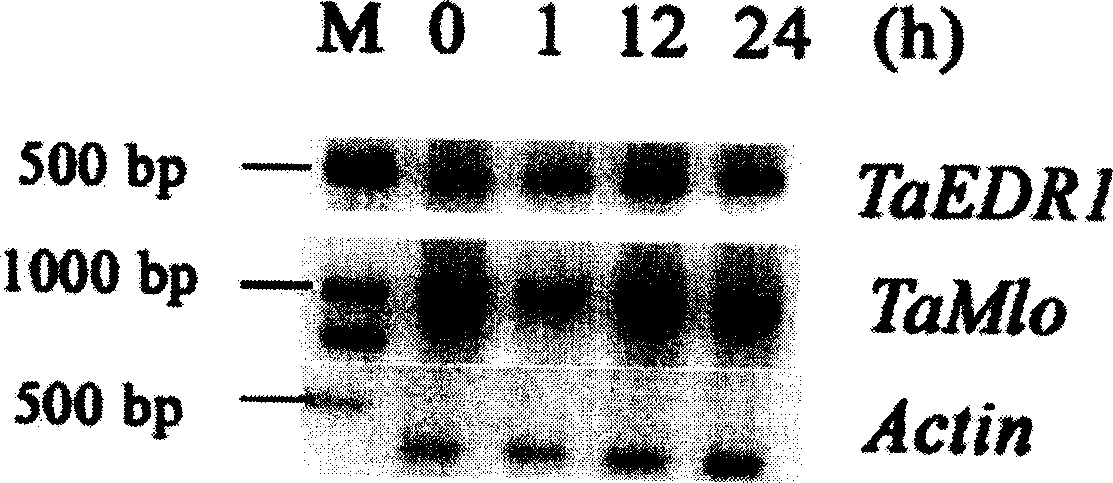Wheat antidisense related gene TaEDR1 and its application
A disease-resistance-related gene, wheat technology, applied in application, genetic engineering, plant genetic improvement and other directions, can solve the problems of wheat disease-resistance gene, wheat disease-resistance-related gene isolation, cloning and less disease resistance response, etc.
- Summary
- Abstract
- Description
- Claims
- Application Information
AI Technical Summary
Problems solved by technology
Method used
Image
Examples
Embodiment 1
[0088] Example 1: Cloning process of wheat disease resistance-related gene TaEDR1:
[0089] Wheat TaEDR1 gene was isolated from a new wheat line "99-2439" with high resistance to powdery mildew. Total RNA (ribonucleic acid) was extracted from leaves 22 hours after powdery mildew induction, and mRNA (messenger ribonucleic acid) was further isolated, and mRNA was transcribed into cDNA (complementary deoxyribonucleic acid) by reverse transcription, and the cDNA was used as a template Perform gene cloning.
[0090] A pair of degenerate primers designed according to the Arabidopsis EDR1 gene and its homologs (the sequence is:
[0091] 5′-GCIGTIAAIAAITTI(T / C)TIGA(T / C)CA(G / A)GA-3′ and 5′-GCIAAIGAIGGIC(G / T)IAI(G / A)TTIGG(G / A)TC-3 '), a 627bp long cDNA fragment representing the wheat TaEDR1 gene was obtained by reverse transcription PCR technology. On the basis of this sequence, a 5'-RACE gene-specific primer (sequence: 5'-CGGAGCCGACGCATAATCCTCACTT-3') was designed, and a 2268bp long...
Embodiment 2
[0133] Example 2: Application of the wheat disease resistance related gene TaEDR1 of the present invention in transgenic disease resistance breeding.
[0134] The TaEDR1 gene was excised from the pGEM-T easy vector, or amplified with high-fidelity Taq-DNA polymerase and gene-specific primers, and TaEDR1 was connected to the maize ubiquitin efficient promoter Ubi( The downstream of Ubiquitin-1) was inserted into the pCAMBIA-Bar plant expression vector, thereby constructing the pCAMBIA-Ubi-TaEDR1 expression vector plasmid. The expression vector is transformed into Escherichia coli DH10B bacterial strain for propagation, and the plasmid of the vector is extracted to carry out transgenic disease-resistant breeding. Transform the pCAMBIA-Ubi-TaEDR1 expression vector plasmid into the callus tissue of immature embryos of wheat varieties with high yield and high quality but poor disease resistance through a gene gun (such as Bio-Rad's high-pressure helium gene gun, PDS-1000 / He). Usin...
Embodiment 3
[0135] Example 3: Application of wheat disease resistance-related gene TaEDR1 in designing and synthesizing new disease resistance-related genes.
[0136] Modern DNA synthesis technology has been able to synthesize a full-length gene. Therefore, according to the difference between the TaEDR1 gene and the HvEDR1 gene, the cDNA encoding the 45th amino acid residue of the HvEDR1 gene was synthesized and the 41st amino acid residue of the TaEDR1 gene was synthesized to the end of the cDNA of the gene. Linked together, so that a new gene is synthesized. Then, the correct coding frame (ORF) of the synthetic gene was verified by sequencing. The verified gene can be further constructed into a plant expression vector, and the disease resistance of the synthetic gene can be tested through transgenic technology. The synthetic gene with good disease resistance can be used for the cultivation of new transgenic disease-resistant wheat varieties, and its plant expression The construction of...
PUM
 Login to View More
Login to View More Abstract
Description
Claims
Application Information
 Login to View More
Login to View More - R&D Engineer
- R&D Manager
- IP Professional
- Industry Leading Data Capabilities
- Powerful AI technology
- Patent DNA Extraction
Browse by: Latest US Patents, China's latest patents, Technical Efficacy Thesaurus, Application Domain, Technology Topic, Popular Technical Reports.
© 2024 PatSnap. All rights reserved.Legal|Privacy policy|Modern Slavery Act Transparency Statement|Sitemap|About US| Contact US: help@patsnap.com









